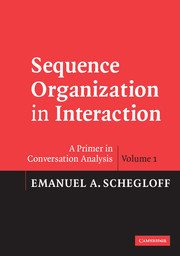Book contents
- Frontmatter
- Contents
- Preface
- Acknowledgments
- 1 Introduction to sequence organization
- 2 The adjacency pair as the unit for sequence construction
- 3 Minimal, two-turn adjacency pair sequences
- 4 Pre-expansion
- 5 The organization of preference/dispreference
- 6 Insert expansion
- 7 Post-expansion
- 8 Topic-proffering sequences: a distinctive adjacency pair sequence structure
- 9 Sequence-closing sequences
- 10 Sequences of sequences
- 11 Retro-sequences
- 12 Some variations in sequence organization
- 13 Sequence as practice
- 14 Summary and Applications
- Appendix 1 Conversation-analytic transcript symbols
- Appendix 2 Transcript of a telephone call
- References
- Index
10 - Sequences of sequences
Published online by Cambridge University Press: 05 September 2012
- Frontmatter
- Contents
- Preface
- Acknowledgments
- 1 Introduction to sequence organization
- 2 The adjacency pair as the unit for sequence construction
- 3 Minimal, two-turn adjacency pair sequences
- 4 Pre-expansion
- 5 The organization of preference/dispreference
- 6 Insert expansion
- 7 Post-expansion
- 8 Topic-proffering sequences: a distinctive adjacency pair sequence structure
- 9 Sequence-closing sequences
- 10 Sequences of sequences
- 11 Retro-sequences
- 12 Some variations in sequence organization
- 13 Sequence as practice
- 14 Summary and Applications
- Appendix 1 Conversation-analytic transcript symbols
- Appendix 2 Transcript of a telephone call
- References
- Index
Summary
When a sequence is brought to a close, whether by its second pair part, by a sequence-closing third, after a more-than-minimal post-expansion, or with a sequence-closing sequence, some new sequence is ordinarily launched, either “next” or after a lapse of some length, whether of silence or of intervening activity. In introducing our discussion of sequence organization we noted that successive turns have a shape to them, relations of mutual relevance and positioning, coherence and orderliness that makes of them not merely a series, but a sequence of turns. Although successive sequences may often be less closely linked than successive turns are, there can be particular ties of relevance between several sequences that serve to extend our sense of the coherence and organizational relatedness of a stretch of talk beyond the boundaries of a single base sequence and its expansions which have so far been sketched. Here we will examine just a few of these types of organization of more than one sequence, or sequences of sequences.
Reciprocal or exchange sequences
By reciprocal or exchange sequences we refer to episodes in which a sequence which has just been initiated by A to B (that is, in which A is the first pair part speaker and B is the second pair part speaker) is then (after it has run its course) reciprocated – initiated by B to A. Same sequence type; reversed speaker/recipient participation.
In some respects, then, this sequence of sequences is akin to “counters.”
- Type
- Chapter
- Information
- Sequence Organization in InteractionA Primer in Conversation Analysis, pp. 195 - 216Publisher: Cambridge University PressPrint publication year: 2007

